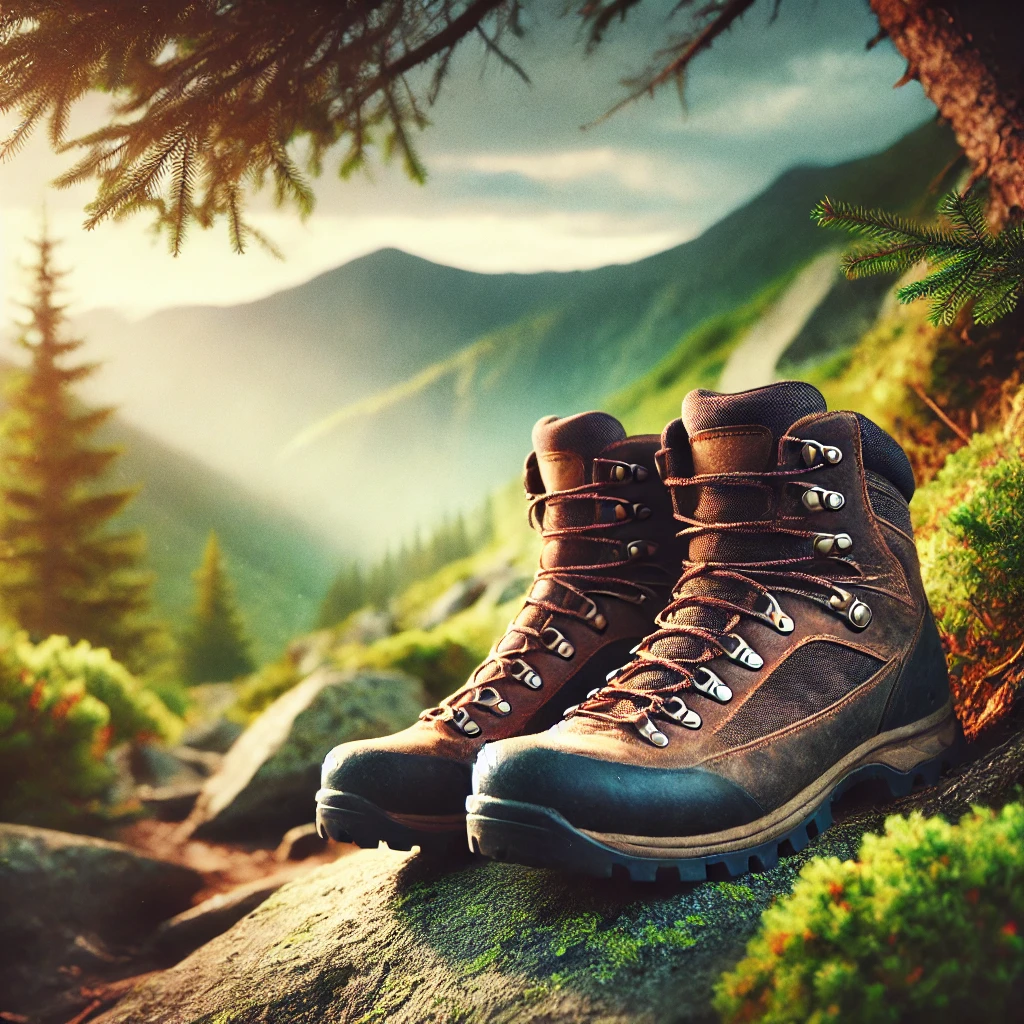
Finding the right pair of hiking boots can make or break your outdoor adventures.
Whether you’re trekking up rocky mountains or walking through muddy trails, having the right footwear ensures your comfort, safety, and overall enjoyment.
In this post, we’ve compiled the top 10 hiking boots for men that are perfect for every type of trail.
Get ready to find your perfect match!
Why Choosing the Right Hiking Boots for Men is Important
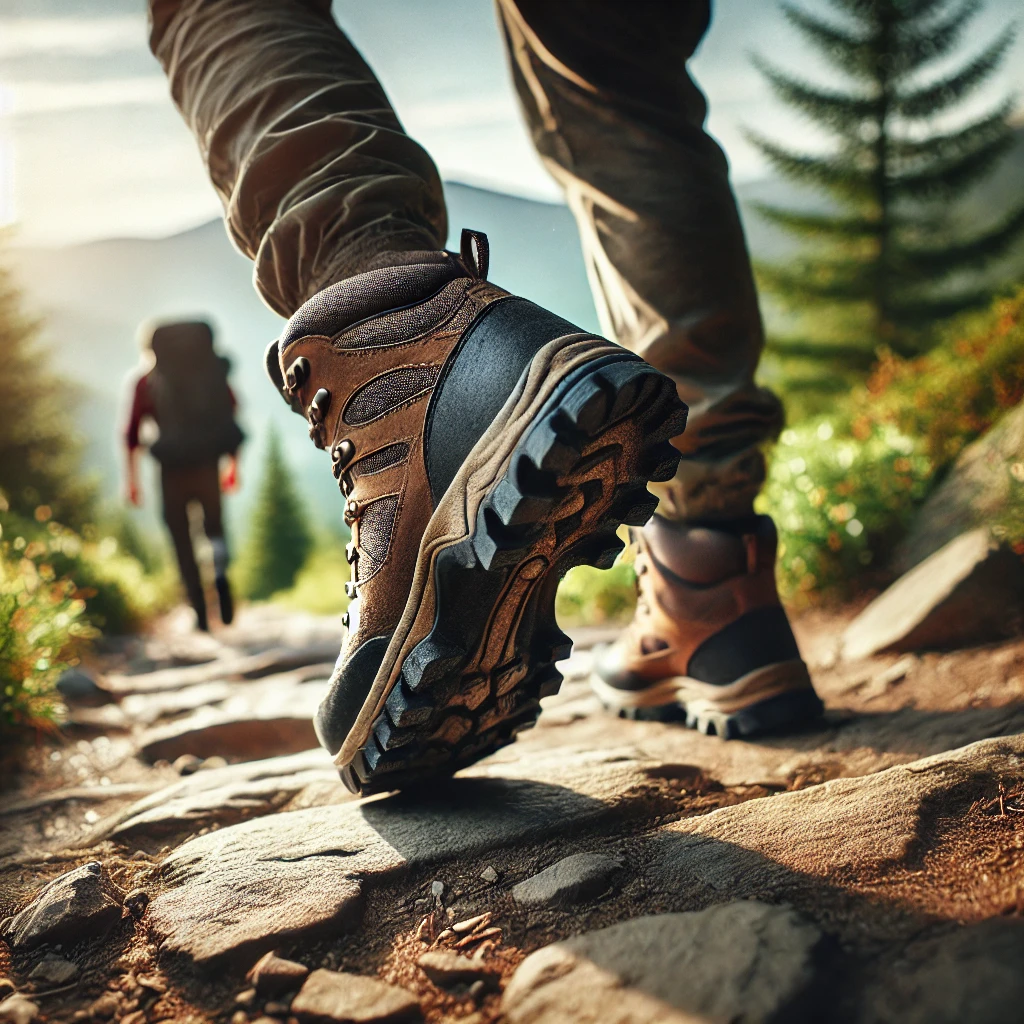
When you’re out in the wilderness, the last thing you want is sore feet, blisters, or a twisted ankle.
A good pair of hiking boots provides the necessary support, protection, and comfort that allows you to focus on the beauty of nature, not the pain in your feet.
Different terrains demand different types of boots—lightweight and breathable for dry, hot climates, or waterproof and sturdy for rainy, rugged conditions.
So, whether you’re tackling steep ascents, navigating rocky paths, or strolling through forests, these boots will ensure you stay comfortable and safe.
Factors to Consider When Buying Hiking Boots for Men
When it comes to buying hiking boots, it’s not just about picking a style you like; there are a variety of critical factors that can significantly impact your overall hiking experience.
Here’s a detailed guide on what to consider to ensure you’re getting the perfect boots for your needs.
1. Comfort
Comfort should be your top priority when choosing hiking boots.
After all, you’ll be spending hours or even days walking in them, and the last thing you want is to deal with blisters, pinching, or discomfort on the trail.
Here’s what to look for:
- Fit: A snug but not tight fit is key. Your heel should stay in place, but you should have enough room in the toe box to wiggle your toes, especially when descending steep trails where your foot will naturally slide forward.
- Cushioning: Look for midsoles that provide enough cushioning to absorb shock, particularly on rocky or uneven terrain. EVA foam midsoles are lighter and more cushioned, while polyurethane midsoles tend to be firmer and more durable, making them ideal for long hikes or carrying heavy backpacks.
- Break-In Time: Some boots require a longer break-in period than others. If you’re planning a long hike, make sure you give your boots enough time to mold to your feet and avoid painful blisters.
2. Durability
Your hiking boots will endure all sorts of rough conditions, from sharp rocks to muddy trails, so they need to be tough enough to last.
Durability often comes down to the materials used in the boot’s construction.
- Materials: Leather, especially full-grain leather, is incredibly durable and can withstand years of use. However, it may not be as breathable as synthetic materials. Synthetic boots (like those made from nylon or polyester) are usually lighter and dry faster but might wear out sooner.
- Stitching and Construction: Pay attention to the quality of stitching and how the boot is put together. Boots with double or triple stitching in high-wear areas like the heel and toe box will typically last longer.
- Toe Cap Protection: Many high-quality hiking boots include reinforced toe caps to protect against rocks and other obstacles on the trail. This feature can extend the lifespan of your boots and protect your feet.
3. Waterproof vs. Breathable
Choosing between waterproof and breathable boots depends largely on the climate and terrain where you’ll be hiking.
- Waterproof Boots: If you frequently hike in wet or rainy conditions, waterproof boots are essential. Look for boots with a waterproof membrane (like Gore-Tex or eVent) that will keep your feet dry while allowing some breathability. However, keep in mind that waterproof boots can sometimes trap heat and moisture inside, making them less ideal for hot climates.
- Breathable Boots: In dry, hot weather, a pair of breathable boots with good ventilation can help keep your feet cool and dry. These are usually made from lightweight mesh materials. Breathable boots are less likely to cause your feet to overheat and can prevent sweat from accumulating, reducing the risk of blisters.
- Water Resistance: For some hikers, water resistance (as opposed to fully waterproof boots) can be a suitable option, especially if they don’t expect to encounter a lot of wet conditions but still want some protection against light rain or damp grass.
4. Traction and Support
The terrain you hike on will determine how much traction and support you need from your boots.
Here’s what to consider:
- Outsoles: The rubber outsole is crucial for providing grip on various surfaces. Look for boots with deep, aggressive lugs (the bumps on the sole) if you’re hiking on muddy, slippery, or steep trails. Vibram soles are popular for their excellent grip and durability.
- Midsole and Stability: The midsole is the layer between the outsole and the boot’s interior, and it helps cushion your foot while providing support. A stiff midsole offers more stability, which is great for uneven terrain, while a more flexible midsole can provide comfort on flat, easy trails.
- Ankle Support: For rough or uneven terrain, consider boots that offer good ankle support to reduce the risk of sprains. Boots that rise above the ankle provide additional support, which is essential when carrying heavy backpacks or navigating rocky trails.
5. Weight
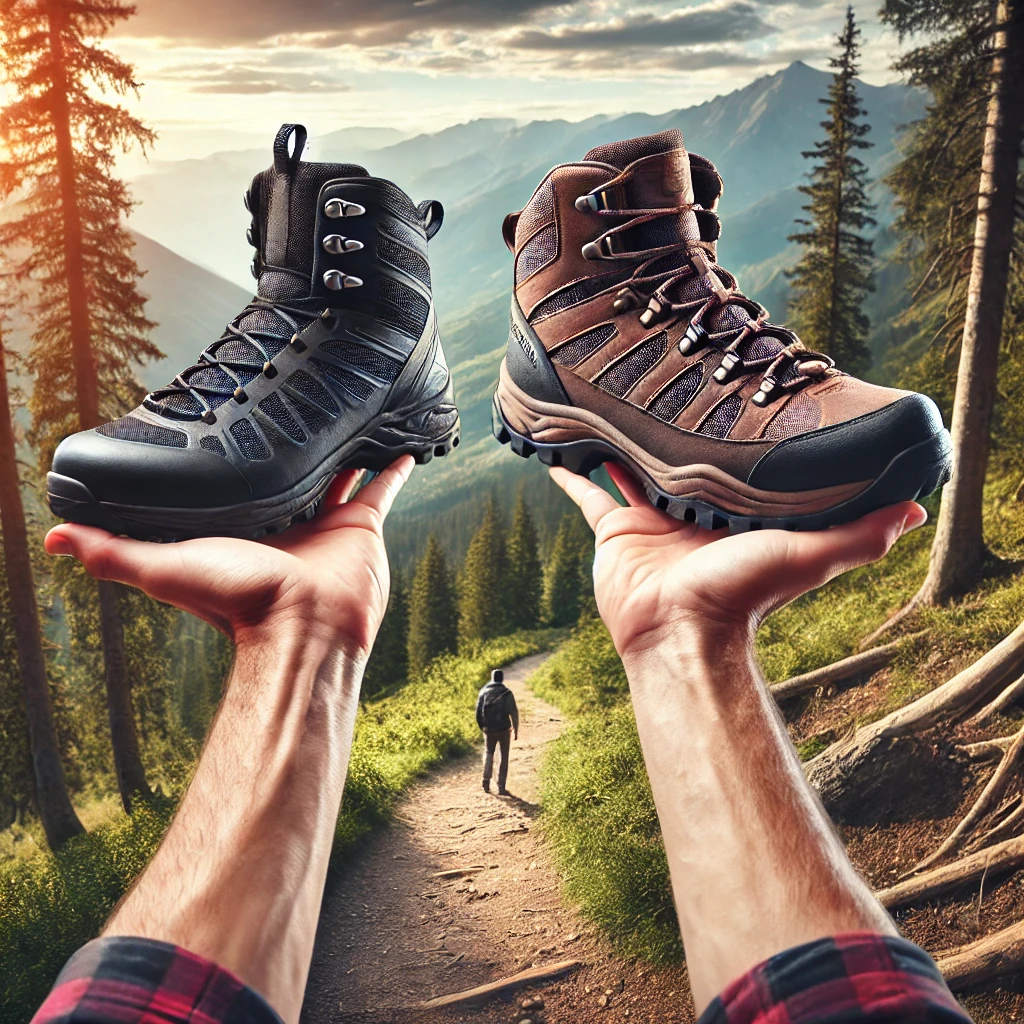
The weight of your hiking boots will directly affect your stamina on long hikes.
Heavy boots may offer more support and durability but can tire you out faster, especially on extended treks.
On the other hand, lightweight boots are less cumbersome and allow for quicker, more agile movement but may not provide the same level of protection or support.
- Lightweight Boots: These are ideal for fast, day hikes on easy trails where minimal support is required. They are often made from synthetic materials and offer better breathability.
- Midweight Boots: Striking a balance between lightweight and heavy boots, these are great for most day hikes and shorter backpacking trips. They offer more support and protection while still allowing for some flexibility and comfort.
- Heavy-Duty Boots: Best for rugged terrain and long-distance backpacking. These boots offer maximum support, especially when carrying a heavy load, but they can slow you down due to their weight.
6. Types of Hiking Boots
There are different types of hiking boots designed for various types of hikes.
Understanding these distinctions can help you choose the right pair for your adventure.
- Day Hiking Boots: These boots are typically lightweight, flexible, and built for short hikes on well-groomed trails. They’re great for casual hikers who don’t need extreme durability or support.
- Backpacking Boots: Designed for multi-day hikes with heavy loads, these boots offer maximum support, ankle protection, and durability. They tend to be stiffer and heavier than day hiking boots, making them ideal for rugged terrain.
- Mountaineering Boots: If you’re tackling technical trails, glacier traverses, or high-altitude climbs, mountaineering boots offer the best protection, stiffness, and warmth. They are built to handle the most extreme conditions and may be compatible with crampons for ice climbing.
7. Fit and Sizing
Getting the right size is critical to avoid discomfort, blisters, or even injury.
Here are some tips to ensure the right fit:
- Sizing Up: When trying on hiking boots, consider sizing up by a half-size to accommodate thicker hiking socks and any foot swelling that may occur during long hikes.
- Testing the Fit: Try your boots on at the end of the day when your feet are naturally more swollen. Walk around indoors and on stairs to ensure your toes don’t hit the front of the boot when going downhill.
- Sock Compatibility: Always try on boots with the same type of hiking socks you plan to wear on the trail. Socks with more cushioning can affect the fit, so make sure the boots aren’t too tight.
8. Price
Hiking boots can range from budget-friendly to premium-priced.
While it can be tempting to go for the cheapest option, investing in a good pair of boots is worth it in the long run.
- Budget Boots ($50 – $100): Suitable for light hiking or casual walkers who stick to well-maintained trails. These boots may not offer the best support or last as long as pricier options.
- Mid-Range Boots ($100 – $200): This price range offers excellent options for most hikers. These boots balance durability, comfort, and support for moderate hikes.
- High-End Boots ($200 and above): Premium boots are typically designed for serious hikers and backpackers. They offer top-tier materials, advanced technologies, and maximum support for extreme conditions and heavy loads.
By carefully considering these factors—comfort, durability, waterproofing, traction, and more—you’ll be well on your way to finding the best hiking boots for your adventures.
Remember that the right pair of boots not only enhances your hiking experience but also keeps your feet healthy and protected in even the toughest conditions.
Top 10 Hiking Boots for Men
1. Salomon X Ultra 4 Mid GTX
- Key Features: Waterproof Gore-Tex, lightweight design, and enhanced stability on rocky terrain.
- Pros:
- Excellent for uneven, technical trails
- Lightweight yet durable
- Advanced traction
- Cons:
- Slightly narrow fit for wider feet
- Ideal For: Rocky or uneven terrain
2. Merrell Moab 2 Mid Waterproof
- Key Features: Waterproof membrane, great cushioning, and reliable durability.
- Pros:
- Comfortable right out of the box
- Breathable mesh lining
- Affordable for the quality
- Cons:
- Not ideal for extended hikes in wet conditions
- Ideal For: Casual day hikes and dry climates
3. KEEN Targhee III Mid Waterproof
- Key Features: Waterproof leather, breathable mesh, and multi-directional lugs for traction.
- Pros:
- Wide fit for more comfort
- Reliable waterproofing
- Superior arch support
- Cons:
- Heavy compared to other boots
- Ideal For: Wet and muddy trails
4. Columbia Newton Ridge Plus II Waterproof
- Key Features: Seam-sealed waterproof construction, lightweight, and durable midsole.
- Pros:
- Great for budget-conscious buyers
- Classic leather style
- Versatile for various terrains
- Cons:
- Not as breathable in hot weather
- Ideal For: Multi-day hikes and various trail conditions
5. Lowa Renegade GTX Mid
- Key Features: Gore-Tex waterproof lining, Vibram outsole for grip, and padded ankle support.
- Pros:
- Long-lasting durability
- Excellent foot and ankle support
- Great for long-distance hiking
- Cons:
- Expensive compared to other models
- Ideal For: Long-distance hikes on rugged terrain
6. HOKA ONE ONE Speedgoat Mid 2 GTX
- Key Features: Gore-Tex waterproofing, lightweight design, and added cushioning for comfort.
- Pros:
- Ultra-lightweight and breathable
- Cushioned sole for extra comfort
- Great for trail running and hiking
- Cons:
- Less ankle support for rougher trails
- Ideal For: Trail running and fast hikes
7. Vasque Breeze AT Mid GTX
- Key Features: Gore-Tex membrane, abrasion-resistant upper, and excellent support.
- Pros:
- Breathable for warmer climates
- Superior traction on tough terrain
- Durable construction
- Cons:
- Requires a break-in period
- Ideal For: Hot and rocky trails
- Price: Check Price on Amazon
8. Scarpa Zodiac Plus GTX
- Key Features: Gore-Tex waterproof lining, durable leather construction, and Vibram outsole.
- Pros:
- Sturdy and durable for tough hikes
- Great ankle support
- Superior traction on all terrains
- Cons:
- Heavy for some hikers
- Ideal For: Technical and alpine hiking
9. La Sportiva Nucleo High II GTX
- Key Features: Waterproof Gore-Tex surround, high breathability, and Vibram Nano sole.
- Pros:
- Lightweight yet durable
- Great for warm and wet conditions
- Versatile on different terrains
- Cons:
- Pricey
- Ideal For: Hiking in varying conditions
10. Danner Mountain 600
- Key Features: Full-grain leather upper, Vibram Fuga outsole, and waterproof barrier.
- Pros:
- Stylish and functional
- Lightweight for everyday use
- Great for casual hikers
- Cons:
- Not ideal for extreme conditions
- Ideal For: Light to moderate trails and everyday wear
Comparison Table
| Boot | Waterproof | Weight | Ideal Terrain | Price |
|---|---|---|---|---|
| Salomon X Ultra 4 | Yes | Medium | Rocky/Uneven | Check Price on Amazon |
| Merrell Moab 2 | Yes | Medium | Dry/Casual | Check Price on Amazon |
| KEEN Targhee III | Yes | Heavy | Muddy/Wet | Check Price on Amazon |
| Columbia Newton Ridge | Yes | Medium | Multi-day/Varied | Check Price on Amazon |
| Lowa Renegade GTX | Yes | Heavy | Rugged/Long-Distance | Check Price on Amazon |
| HOKA Speedgoat Mid 2 | Yes | Light | Trail Running/Fast Hikes | Check Price on Amazon |
| Vasque Breeze AT | Yes | Medium | Hot/Rocky | Check Price on Amazon |
| Scarpa Zodiac Plus | Yes | Heavy | Technical/Alpine | Check Price on Amazon |
| La Sportiva Nucleo High | Yes | Light | Warm/Wet Conditions | Check Price on Amazon |
| Danner Mountain 600 | Yes | Light | Light/Moderate Trails | Check Price on Amazon |
How to Care for Your Hiking Boots
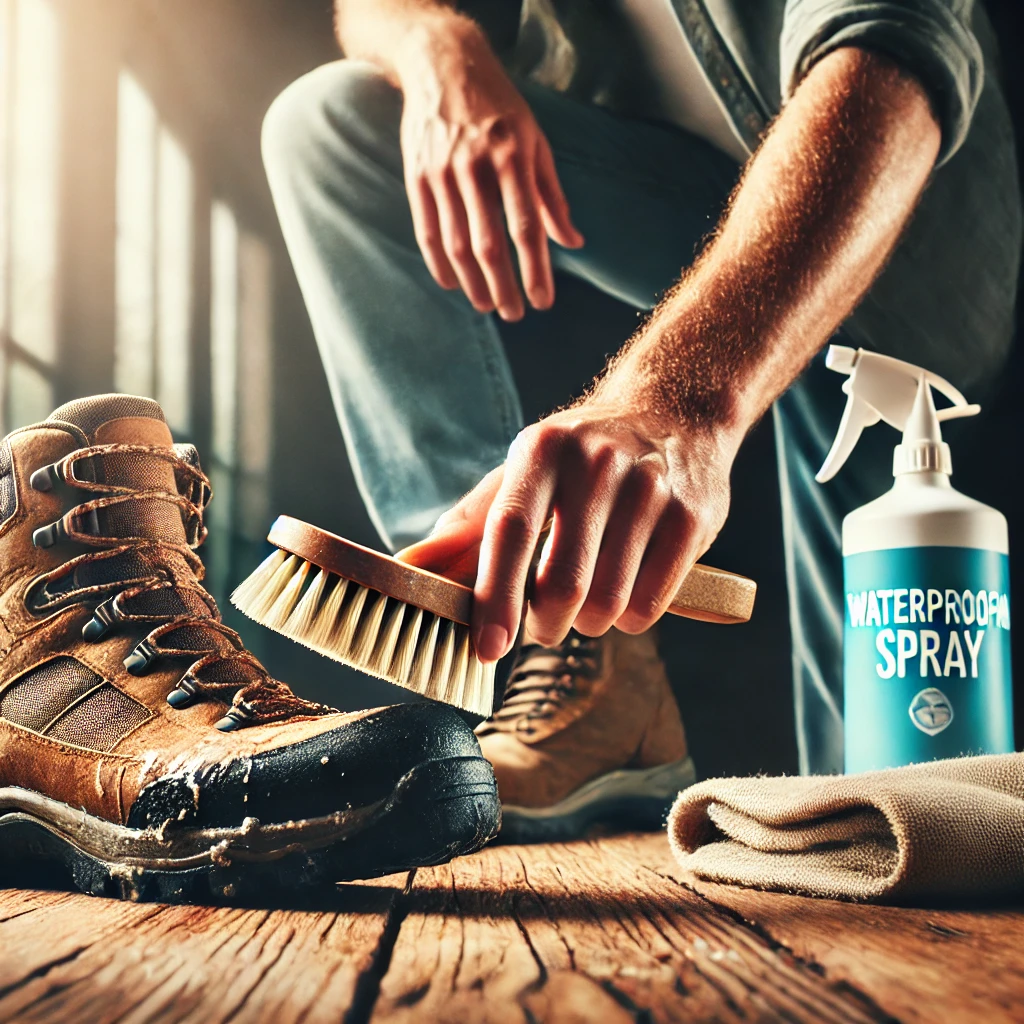
Investing in a quality pair of hiking boots is essential for enjoying your outdoor adventures, but to make the most of your boots and ensure they last for years, proper care and maintenance are equally important.
Here’s a detailed guide on how to take care of your hiking boots before, during, and after your hikes to maintain their performance and durability.
1. Clean Your Boots After Every Hike
Regular cleaning is the foundation of proper boot care.
Dirt, mud, and debris can damage your boots over time, wearing down the materials and affecting their water resistance.
- Remove Loose Dirt and Mud: After each hike, use a soft brush or an old toothbrush to remove dirt and mud from the boots, paying particular attention to the seams and soles. For stubborn mud, you can use a damp cloth or rinse the boots under cool, running water.
- Remove Insoles and Laces: Take out the insoles and laces before cleaning the boots, as they can trap dirt and moisture. Wash the laces separately, and wipe down the insoles with a damp cloth. Allow both to air dry.
- Clean the Outsoles: Use a stiff-bristle brush to scrub the outsoles and remove stuck rocks, mud, or other debris from the treads. This not only keeps your boots clean but also ensures good traction on your next hike.
2. Deep Clean as Needed
For more thorough cleaning, especially after long hikes or when your boots are particularly dirty, you may need to deep clean your hiking boots.
- Use Mild Soap or Special Cleaners: If your boots are very dirty, use a small amount of mild soap or a boot-specific cleaner. Avoid harsh detergents, as they can damage the boot’s materials, especially waterproof membranes. Apply the cleaner to the exterior of the boot with a brush or cloth, gently scrubbing away dirt.
- Rinse Carefully: After cleaning, rinse your boots thoroughly under cool water to ensure no soap or cleaner residue remains, as it can damage the materials over time.
- Avoid Submerging: Never fully submerge your boots in water, especially leather ones, as it can damage their structure and reduce their lifespan.
3. Dry Your Boots Properly
Proper drying is crucial to prevent moisture from weakening your boots’ materials and causing odor or mold to develop.
Always allow your boots to dry thoroughly before storing them.
- Air-Dry Your Boots: The best way to dry your boots is by allowing them to air dry naturally. Place them in a well-ventilated area away from direct sunlight or any heat sources, such as a radiator or heater. High heat can warp or crack the leather and degrade synthetic materials, reducing the boots’ waterproofing and durability.
- Stuff with Newspaper: To speed up the drying process, stuff your boots with crumpled newspaper or paper towels. This will help absorb moisture from the inside and maintain the boot’s shape as it dries. Change the newspaper every few hours until the boots are dry.
- Remove Insoles and Open Laces: Always remove the insoles and fully loosen the laces to allow proper airflow inside the boot.
4. Reapply Waterproof Treatments
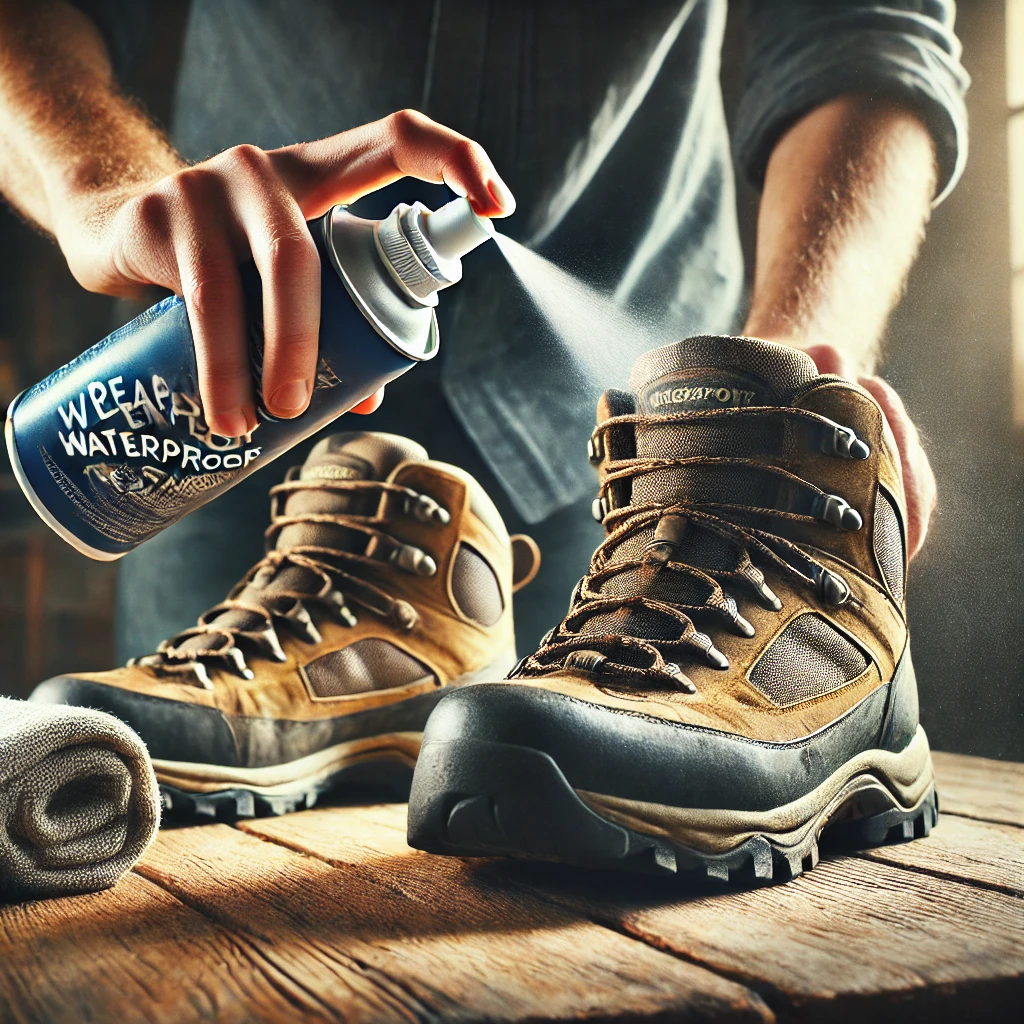
Even waterproof boots lose some of their water-resistant properties over time, especially if frequently exposed to water, mud, or snow.
Reapplying a waterproof treatment periodically will help restore the boot’s water resistance and prolong its lifespan.
- Choose the Right Waterproofing Product: There are several types of waterproof treatments available, including sprays, waxes, and creams. Be sure to choose a product that matches the material of your boots (e.g., a wax for leather boots or a spray for synthetic boots).
- Apply After Cleaning and Drying: Reapply the waterproof treatment only after the boots have been cleaned and thoroughly dried. Follow the instructions on the product, applying an even layer across the exterior of the boots.
- Repeat as Needed: Depending on how often you hike and the conditions, you may need to reapply the waterproof treatment every few months or after particularly wet hikes.
5. Condition Leather Boots
Leather boots, in particular, require conditioning to prevent the leather from drying out, cracking, or stiffening.
This is especially important if your boots are exposed to extreme weather conditions.
- Use Leather Conditioner: Apply a leather conditioner (specifically designed for boots) to nourish and soften the leather. This will keep the boots flexible and improve their water resistance.
- Avoid Over-Conditioning: Be cautious not to over-apply the conditioner, as too much can soften the leather excessively, reducing the boot’s support and structure.
6. Store Your Boots Properly
Proper storage is essential for maintaining the shape, condition, and longevity of your hiking boots.
Poor storage habits, such as leaving them in a hot, damp area, can damage the materials and lead to unpleasant odors.
- Cool, Dry Place: Store your boots in a cool, dry place away from direct sunlight, which can cause the materials to fade and degrade. Avoid damp areas like basements, which can cause mold and mildew to grow inside the boots.
- Keep Them Upright: If possible, store your boots upright to maintain their shape. You can use boot shapers or stuff them with newspaper to help retain their form. Avoid piling other items on top of your boots, as this can warp their shape.
- Regular Airing: If you haven’t used your boots in a while, air them out every few months to prevent the growth of mold and mildew.
7. Rotate Between Multiple Pairs
If you hike often, it’s a good idea to own more than one pair of hiking boots.
Alternating between pairs will allow each one to fully dry and recover between hikes, extending their lifespan.
Rotating boots also reduces wear and tear on a single pair, making them last longer.
8. Inspect for Damage and Make Repairs
Regularly inspecting your boots for damage is important for maintaining their longevity.
Even minor issues like loose stitching or worn-out laces can become bigger problems if not addressed promptly.
- Check Seams and Stitching: Inspect the seams for any signs of fraying or loose stitching. If you notice any issues, repair them before they worsen.
- Replace Laces and Insoles: Don’t hesitate to replace worn-out laces or insoles, as these can cause discomfort and reduce your boots’ performance.
- Sole Replacement: If the outsole starts to wear down but the upper part of your boots is still in good condition, you can take them to a professional cobbler to have the soles replaced, extending the life of your boots without needing to buy a new pair.
9. Avoid Common Boot-Care Mistakes
Finally, be mindful of some common mistakes that can shorten the life of your hiking boots:
- Avoid Excessive Heat: Drying your boots with direct heat from a fireplace, heater, or hair dryer can warp or damage the materials. Always air-dry naturally.
- Don’t Machine Wash: Never put your boots in a washing machine, as this can damage the structure and materials. Hand cleaning is always the best method.
- Avoid Prolonged Submersion: Even waterproof boots shouldn’t be submerged in water for long periods, as this can degrade waterproof membranes and weaken the glue that holds the boot together.
By following these care steps, you can significantly extend the life of your hiking boots and ensure they remain comfortable and functional on every adventure.
Proper cleaning, drying, and maintenance not only preserve the quality of your boots but also protect your feet from discomfort, blisters, and potential injuries while hiking.
Final Thoughts
Investing in the right hiking boots for men is essential for ensuring comfort, safety, and durability on any trail.
Whether you’re a casual day hiker or a seasoned adventurer, these top 10 picks cover every need and budget.
Don’t let uncomfortable shoes hold you back—grab the perfect pair today!
Related Articles:
Hiking Jacket Breakdown: From Types to Top-rated Picks
Top Hiking Shoes for Women: A Comprehensive Review
As an Amazon Associate I earn from qualifying purchases.


